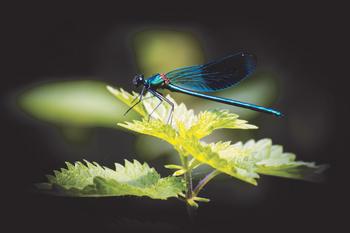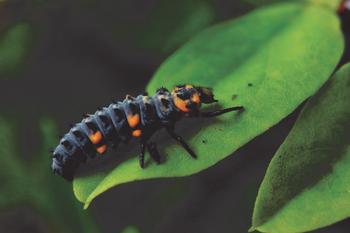Good guys in the garden
-
Wendy Irving
-
Some years ago, in an effort to create a more environmentally-friendly garden at home, I decided to limit the use of insecticides as much as possible. I was reluctant at first, afraid that my garden would become overrun by invading, gnawing pests! But I decided that I would keep a careful eye on things. If I saw any chewing or sucking insects I would use the pick and crush method, or, my preference, wash them away. At the same time, I thought I should familiarize myself with the “good guys” I had heard about through my Marin Master Gardener education – those wonderful beneficial insects that feed on the “bad guys” that love to eat my ornamentals and edibles. They are the very same ones I was inadvertently killing off with the pesticides I was using.
 Not only is this dragonfly beautiful, it helps control garden pests like aphids, midges and mosquitoes. Photo: Gbfoto/Dreamstime.com
Not only is this dragonfly beautiful, it helps control garden pests like aphids, midges and mosquitoes. Photo: Gbfoto/Dreamstime.comI couldn’t find very many beneficial bugs when I first started to look for them and I had to do more manual destruction of pests than I wanted. I became more careful about controlling aphids and scale in the garden, learning that they supply honeydew on which some bad guys like ants thrive. But, over the course of time, the population of good garden bugs increased and I was seeing more ladybugs, dragonflies and lacewings, and fewer destructive insects, particularly aphids. My garden is by no means free of any type of bug damage, but the population of good and bad bugs seems balanced to a place that I can accept. I have reconciled to the fact that in order to have the good guys you have to have something for them and their larvae to eat.
Most gardeners know about ladybugs and their appetite for aphids. But ladybug larvae are voracious eaters of aphids, and depending on the species, will gobble up scale, mites, mealybugs and whiteflies as well. Gardeners need to know that ladybug larvae is not as “cute” as the ladybug. In fact, the larva is pretty ugly and looks just like what you would imagine a “bad” bug to look like! Other beneficials we find in our California gardens are assassin bugs, soldier bugs, and some types of thrips, wasps, and spiders. This is by no means all. A handy laminated guide called Mac’s Field Guide to Good and Bad Garden Bugs in California is available online. It also lists the habitats in which you will most likely find damaging insects and identifies those insects. The UC Marin Master Gardener Help Desk is also a good source for bug identification, but is only taking inquiries by email during the pandemic. (HelpDesk@marinmg.org). Another source of info is The New Sunset Western Garden Book starting on page 726. Once you know the insects in your garden and their lifecycles, they will be easier for you to control – or encourage. Emerging from a cluster of bright yellow eggs and becoming a larva, a ladybug can consume 5,000 aphids in a lifetime. Photo: Bostet1962/Dreamstim
Emerging from a cluster of bright yellow eggs and becoming a larva, a ladybug can consume 5,000 aphids in a lifetime. Photo: Bostet1962/DreamstimAs bad bugs are attracted to certain environments, so are the good guys. Of course, they need food, water and shelter, but they like a wide variety of flowering plants, like daisies and marigolds, and herbs, like rosemary and dill. Try to keep all your plants clean and free of dust. Don’t over irrigate or over fertilize at first, as fresh lush growth may attract so many bad guys that the good guys can’t keep up. Most importantly, avoid pesticides as much as possible, especially ones combined with plant food. These can kill a beneficial outright or later, perhaps when a ladybug eats the aphid that dined on an impacted plant.
Looking for something “beneficial” to do while we are all staying close to home? Spend some time in the garden looking at the insects that live there and familiarizing yourself with them. Encouraging beneficial insects in your garden takes a little knowledge, some common sense . . . and lots of patience, but worth it all in the end.


